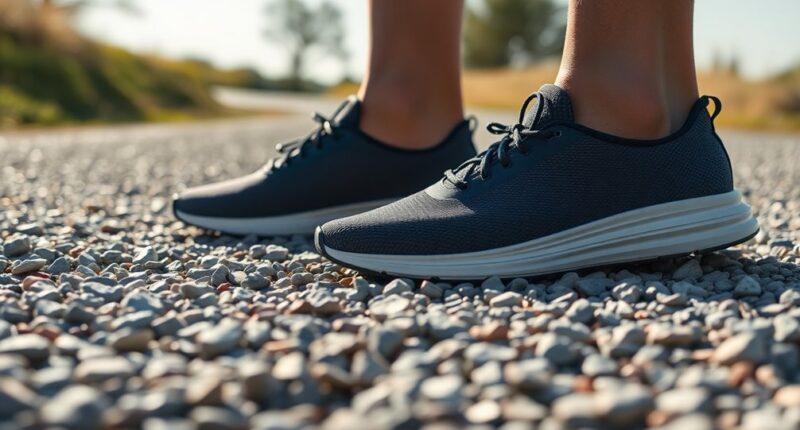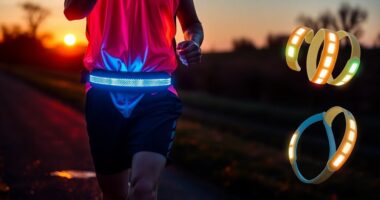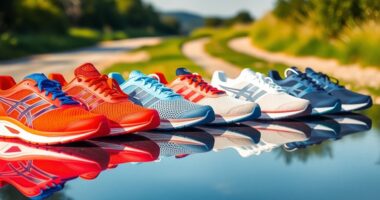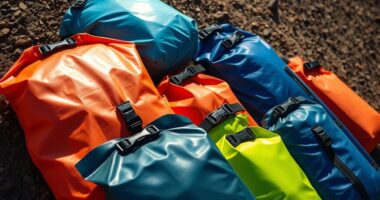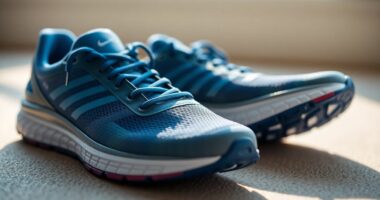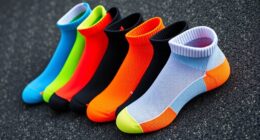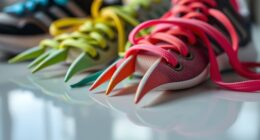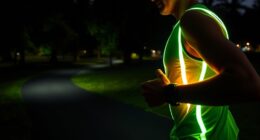If you're looking for lightweight, comfortable, and performance-driven minimalist trainers, I've got you covered! The WHITIN Mens Barefoot Running Shoes and the WHITIN Minimalist Trail Runner are both fantastic options. They offer a natural feel with a wide toe box. Brands like Oranginer and Nike also have great choices. With various designs and price ranges, you'll easily find the perfect pair. Stick around to explore the top picks and factors to evaluate for your ideal trainers!
Key Takeaways
- Look for lightweight designs that enhance comfort and flexibility, reducing fatigue during long runs.
- Choose trainers with a zero drop sole to promote natural foot movement and improve ground connection.
- Ensure a wide toe box for natural toe spread, enhancing comfort and stability while running.
- Opt for breathable materials to regulate temperature and minimize blisters during extended wear.
- Consider models with excellent grip and traction for better performance on various terrains, especially wet surfaces.
WHITIN Mens Barefoot Running Shoes
If you're looking for a shoe that promotes a natural running experience, WHITIN Mens Barefoot Running Shoes are an excellent choice for minimalist enthusiasts. These shoes wrap around my feet snugly, providing great comfort without unnecessary padding. I've worn them for everything from gym workouts to light hikes, and they perform well on various terrains. While the toe box is a bit streamlined, the flexibility allows my feet to move naturally. They offer excellent grip on dry surfaces, though I've noticed a bit of slipperiness in wet conditions. Overall, at around $35, they're a solid value for quality minimalist footwear.
Best For: Minimalist running enthusiasts and casual users seeking a natural foot movement experience for various activities.
Pros:
- Flexible design allows for natural foot movement, enhancing comfort during activities.
- Good grip on dry surfaces, providing stability and confidence while running or walking.
- Affordable price point (around $35-$43) offers great value for quality minimalist footwear.
Cons:
- Toe box may feel narrow for some users, potentially affecting comfort for those with wider feet.
- Slippery on wet surfaces, which can be a concern for outdoor use in rainy conditions.
- Minimal cushioning may not be suitable for individuals who prefer more padding in their footwear.
WHITIN Mens Minimalist Trail Runner | Wide Toe Box | Barefoot Inspired
The WHITIN Mens Minimalist Trail Runner stands out primarily for its wide toe box, making it an excellent choice for runners who crave a natural, unrestricted fit. I find these shoes incredibly lightweight and comfortable, almost like wearing house slippers. While sizing can be tricky, I recommend checking the size guide, as some users suggest sizing down. They perform well on light trails, improving my balance and grip on rocky surfaces. Although I've noticed some wear after several months, the durability of the sole remains impressive. Overall, these shoes offer great value for anyone seeking a minimalist running experience.
Best For: Runners and outdoor enthusiasts seeking a comfortable, minimalist shoe with a wide toe box for natural foot movement.
Pros:
- Lightweight and comfortable, akin to wearing house slippers.
- Excellent grip and balance on rocky surfaces, making them suitable for light trails.
- Affordable pricing compared to other minimalist footwear, offering great value.
Cons:
- Sizing can be inconsistent, with some users recommending to size down.
- Durability issues reported after 6-9 months of daily use.
- May not be suitable for hard forest trails or very rugged terrains.
WHITIN Mens Minimalist Trail Runner | Wide Toe Box | Barefoot Inspired
For runners seeking a natural feel and freedom of movement, the WHITIN Mens Minimalist Trail Runner stands out with itsand barefoot-inspired design. I've found these shoes incredibly comfortable, almost like wearing slippers. They perform well across various activities, from trail running to yard work, allowing me to stay connected to the ground despite minimal cushioning. Durability impresses me too; after logging 250 miles, they still hold up well. Just remember to size up, as I've noticed some inconsistencies. Overall, I'd definitely recommend these shoes for anyone looking for affordable, effective minimalist footwear.
Best For: Runners and outdoor enthusiasts seeking a comfortable, minimalist shoe that allows for natural movement and ground connection.
Pros:
- Exceptional comfort: Lightweight design feels like wearing slippers, making them suitable for various activities.
- Versatile performance: Effective for trail running, walking, and other outdoor tasks across different terrains.
- Good durability: Holds up well with extensive use, maintaining performance over significant mileage.
Cons:
- Sizing inconsistencies: Users may need to size up due to variation between different colors.
- Wear over time: Some users report noticeable wear after extensive daily use, particularly under the heel.
- Style limitations: While functional, the minimalist design may not appeal to those seeking a more fashionable look.
WHITIN Mens Barefoot Running Shoes
Designed for those who crave a natural running experience, WHITIN Mens Barefoot Running Shoes excel with their zero drop sole and flexible construction. I found them to be incredibly comfortable, hugging my feet like a glove. The wide toe box allows my toes to spread naturally, which I love. They perform well on dry surfaces, though I did notice they can be slippery on wet ground. Priced around $35 to $43, they offer great value for anyone looking to try barefoot footwear. Just keep in mind that sizing can be tricky; I recommend ordering a size down for the best fit.
Best For: Individuals seeking a comfortable and versatile minimalist shoe for casual wear, gym workouts, and light hiking.
Pros:
- Glove-like fit that provides excellent comfort and support.
- Wide toe box allows for natural toe splay, enhancing comfort during various activities.
- Affordable price range of $35 to $43 offers great value for those exploring barefoot footwear.
Cons:
- Sizing can be tricky, with some users recommending ordering a size down for a better fit.
- May feel slippery on wet surfaces, impacting performance in rainy conditions.
- Thin soles can lead to discomfort on hard or uneven surfaces during prolonged use.
Oranginer Mens Barefoot Shoes for Cross Training
With a spacious toe box and a minimalist design, Oranginer Mens Barefoot Shoes are perfect for those who appreciate the natural feel of running and walking. I found them ideal for cross-training activities like squatting and deadlifting. The snug fit accommodates wider feet, and the cushioning makes them great for various terrains. I recommend ordering half a size up for better comfort. While the minimal padding offers a natural experience, I did notice some grip issues on wet surfaces. Overall, these shoes provide solid performance and durability, making them a worthwhile investment for minimalist footwear enthusiasts.
Best For: Those seeking minimalist footwear for cross-training and outdoor activities who value a natural feel and comfort.
Pros:
- Comfortable fit with a spacious toe box and snug design, accommodating wider feet.
- Great performance in various terrains, making them suitable for hiking and gym workouts.
- Durable construction with good quality materials that withstand regular use.
Cons:
- Limited grip on wet surfaces, which may affect performance in certain conditions.
- Potential sizing inconsistencies, with some users needing to order half a size larger or experiencing different sizes for each foot.
- Minimal padding, which may require an adjustment period for those used to more cushioned footwear.
Joomra Womens Trail Running Barefoot Shoes
The Joomra Women's Trail Running Barefoot Shoes stand out as an excellent choice for those seeking comfort and flexibility in their footwear. I've found them incredibly comfortable, perfect for all-day wear without discomfort. The wide toe box accommodates my foot shape, and I've even experienced relief from foot issues like Morton's Neuroma. They're surprisingly durable, washing well without losing their appeal. Plus, they're versatile enough for activities like walking or gym workouts. I love the trendy designs and appreciate that they're easy to slip on. Overall, I highly recommend grabbing a pair—or two!
Best For: Those seeking comfortable, flexible footwear for various activities, especially individuals with foot issues like Morton's Neuroma or Plantar Fasciitis.
Pros:
- Incredibly comfortable and flexible, suitable for all-day wear.
- Durable and easy to maintain, machine washable without losing quality.
- Versatile design works well for multiple activities, from walking to gym workouts.
Cons:
- Limited arch support may not be ideal for long-distance running.
- Some users report fit variations between different styles.
- The wide toe box may be too roomy for individuals with narrower feet.
WHITIN Mens Cross-Trainer Barefoot & Minimalist Shoe
For those seeking a true barefoot experience, the WHITIN Mens Cross-Trainer Barefoot & Minimalist Shoe stands out with its zero drop sole and wide toe box. I've found it incredibly comfortable for all-day wear, whether I'm running or working. The grip on wet surfaces is impressive, and it handles trails easily. While some users mentioned the toe box could be wider, I appreciated the roomy fit. Plus, for just $27, I can't complain. The lacing system is straightforward, and replacement insoles are a steal at $2.99. Overall, it's a solid choice for anyone looking for performance and comfort.
Best For: Those seeking a comfortable and versatile shoe for everyday use, running, and outdoor activities at an affordable price.
Pros:
- Excellent grip on wet surfaces and trails, enhancing performance in various conditions.
- Roomy toe box provides comfort for extended wear, making it suitable for active lifestyles.
- Affordable price point with the option for inexpensive replacement insoles.
Cons:
- Some users report that the toe box could be wider for optimal comfort.
- Insole wear can occur after heavy use, needing replacement sooner than expected.
- A few users experienced fit issues, requiring adjustments like removing insoles for comfort.
Mens Barefoot Zero Drop Running Shoes for Gym and Cross Training
If you're looking for a shoe that combines comfort and performance, mens barefoot zero drop running shoes stand out as an ideal choice for gym enthusiasts and cross-training aficionados alike. Their zero drop design enhances comfort and minimizes back pain, while the lightweight, flexible build makes them easy to pack. I appreciate the breathable knit material, though I've noticed it can feel narrow for wider feet. While some find the sole a bit slippery, the overall quality and value are impressive. These shoes fit snugly, and with a bit of break-in time, they're perfect for daily workouts and casual wear.
Best For: Athletes and casual wearers seeking a comfortable, lightweight shoe for gym workouts and cross-training activities.
Pros:
- Lightweight and flexible design makes them easy to pack for travel.
- Zero drop feature enhances comfort and reduces back pain during workouts.
- Breathable knit material provides a sock-like feel for added comfort.
Cons:
- Sizing inconsistencies may lead to a snug fit for some users.
- The wide toe box may feel narrow for those with wider feet.
- The thin sole can be slippery, posing a risk during certain activities.
Xero Shoes Barefoot Prio Running Shoes for Men
Designed for those who appreciate a natural running experience, Xero Shoes Barefoot Prio Running Shoes for Men excel in providing a zero drop, minimalist feel. I love how these shoes wrap my feet in comfort without excessive foam. The wide toe box gives my toes room to breathe, while the durable sole guarantees great grip on any surface. Initially, I felt some soreness adjusting to the zero drop, but that quickly faded as my strength built. Whether I'm hitting the gym or running errands, these shoes deliver versatility and support. Plus, they're reasonably priced for such quality!
Best For: Those seeking a comfortable, minimalist shoe that promotes a natural foot movement and is versatile for various activities.
Pros:
- High comfort with a plush feel and ample toe space.
- Excellent grip and traction on multiple surfaces.
- Versatile for both workouts and casual outings.
Cons:
- May not be ideal for running due to bulkiness.
- Initial soreness can occur for new users of zero drop design.
- Limited color options and aesthetic preferences may vary.
Weweya Barefoot Shoes Men Minimalist Running Cross Training Shoe
The Weweya Barefoot Shoes are perfect for those who crave a natural running experience without sacrificing comfort. They fit true to size, though some might find them a bit larger than usual. The toe box can feel snug for wider feet, so consider that when choosing your size. I love how they allow my feet to move naturally, and I haven't experienced any arch pain. They're versatile enough for running, hiking, or just lounging around. Plus, they're lightweight and durable, making them a great everyday choice, even if they don't always turn heads in the style department.
Best For: Those seeking a comfortable and versatile minimalist shoe for various activities like running, hiking, and lounging.
Pros:
- Lightweight design allows for natural foot movement and flexibility.
- Comfortable fit with no reported arch pain, suitable for extended wear.
- Durable construction that holds up well over time despite an affordable price.
Cons:
- Toe box may be snug for individuals with wider feet, causing discomfort.
- Slightly larger sizing might necessitate trying different sizes for the best fit.
- Aesthetic appeal may not meet everyone's taste, leading to mixed opinions on style.
WHITIN Mens Barefoot Trail-Running Shoes
For runners seeking a natural foot movement experience, the WHITIN Mens Barefoot Trail-Running Shoes excel with their wide toe box and zero-drop sole. I found them incredibly lightweight and comfortable, almost like wearing slippers. The thin removable insole adds flexibility, though I noticed they might be loose for some folks. They work well for various activities but can feel less cushioned on rough terrain. After several months of use, they held up well despite some wear on the tread. Just be cautious on wet surfaces, as traction can be limited. Overall, they're a fantastic affordable option for minimalist shoe lovers.
Best For: Runners and outdoor enthusiasts seeking a lightweight, comfortable shoe that promotes natural foot movement and is suitable for casual wear.
Pros:
- Wide toe box allows for natural toe spread and comfort.
- Lightweight and breathable design enhances overall comfort, making them feel like slippers.
- Durable construction with well-stitched seams and effective rubber sole grip.
Cons:
- Some users may find the wide option too loose, affecting security.
- Limited cushioning on rough terrain may lead to discomfort during extended use.
- Traction can be lacking on wet surfaces, necessitating caution in slippery conditions.
WHITIN Womens Wide Minimalist Barefoot Shoes | Zero Drop Sole
If you're someone who values comfort and a natural foot position while running, WHITIN Women's Wide Minimalist Barefoot Shoes with a zero drop sole are a fantastic choice. I love the wide toe box, which fits my feet perfectly without cramping. They're super lightweight and easy to slip on, making them great for various activities. The extra heel padding adds a nice touch of comfort, and I've found them to have excellent grip, even on tricky terrain. While the packaging could be better, the shoes themselves have exceeded my expectations—just be ready for a little adjustment period when adapting to minimalist footwear!
Best For: Individuals seeking comfortable, wide-fitting footwear that promotes a natural foot position for various activities.
Pros:
- Lightweight design with a wide toe box for enhanced comfort and style.
- Excellent grip and stability on challenging terrains, making them versatile for activities like hiking and weight lifting.
- Easy to slip on and off, with extra padding near the heel for added comfort.
Cons:
- Packaging concerns, as shoes arrive in shrink-wrapped plastic bags without original brand packaging.
- Some users may experience a discomfort transition period when adapting to minimalist footwear.
- Long-term durability remains a concern for some based on past experiences with similar products.
WHITIN Womens Barefoot & Minimalist Shoe | Zero Drop Sole | Trail Runner
Looking for a shoe that combines comfort and functionality? The WHITIN Womens Barefoot & Minimalist Shoe is a fantastic choice for trail runners. With its zero drop sole, it promotes natural foot movement, making it perfect for various activities from running to casual walks. I love how lightweight and comfortable they are; I can wear them all day without any discomfort. The fit is spot-on according to the size guide, and the wide toe box helps prevent blisters. Plus, they're durable enough to withstand outdoor adventures while still looking stylish. You won't regret giving these shoes a try!
Best For: Those seeking a comfortable, lightweight shoe for everyday use, trail running, and individuals with foot issues like plantar fasciitis.
Pros:
- Lightweight and comfortable, allowing for all-day wear without discomfort.
- Zero drop sole promotes natural foot movement, suitable for various activities.
- Durable design holds up well during outdoor activities and sports.
Cons:
- Some users may experience blistering during extreme walking, depending on individual foot anatomy.
- Not all users find them suitable to wear with skinny jeans due to their design.
- Aesthetic appeal may not cater to everyone's fashion preferences.
WHITIN Mens Wide Minimalist Barefoot Sneakers
The WHITIN Mens Wide Minimalist Barefoot Sneakers stand out as an excellent choice for runners with flat, wide feet. I found the fit snug at the heel and wider at the toe, making it comfortable for longer walks. Although I initially ordered a size 10, I eventually settled on a size 9 for the perfect length. These sneakers offer a minimal cushioning that gives a barefoot feel, though they're better suited for forefoot runners. With a stylish design and affordable price, they've become my go-to for casual wear and workouts, proving durable enough for regular use.
Best For: Those with flat, wide feet looking for a comfortable, minimalist sneaker for casual use and light workouts.
Pros:
- Comfortable fit with a snug heel and wider toe box, ideal for long walks.
- Affordable price point at $40, making them a great entry-level minimalist shoe.
- Durable construction that holds up well with regular use, lasting several months.
Cons:
- Not suitable for heel strikers, as they provide minimal cushioning and may cause discomfort.
- Sizing can be tricky, requiring potential adjustments to find the ideal fit.
- Limited style options, with a desire for more variations to match different occasions.
Nike mens Free Run Flyknit 2018 Running
For those who value a blend of comfort and style, the Nike mens Free Run Flyknit 2018 is an exceptional choice. This lightweight shoe feels almost like a second skin, and I often forget I'm wearing them. They fit various foot shapes well, especially if you have narrow ankles. I've taken them on long walks and casual runs without any blisters or discomfort. While they excel in everyday use, I wouldn't recommend them for fast-paced activities. Plus, their durability means I can count on them lasting for months, making them a fantastic value for anyone's footwear collection.
Best For: Those seeking a comfortable and stylish shoe for everyday wear and moderate running.
Pros:
- Highly comfortable and lightweight, often feeling like a second skin.
- Versatile design that fits various foot shapes, particularly beneficial for narrow ankles.
- Durable construction, lasting several months with regular use.
Cons:
- Not suitable for fast-paced activities or sprints due to limited ankle support.
- May require replacement every 6-10 months with extensive use.
- Less effective for sharp turns or intense running, potentially leading to ankle issues.
Factors to Consider When Choosing Minimalist Trainers for Runners
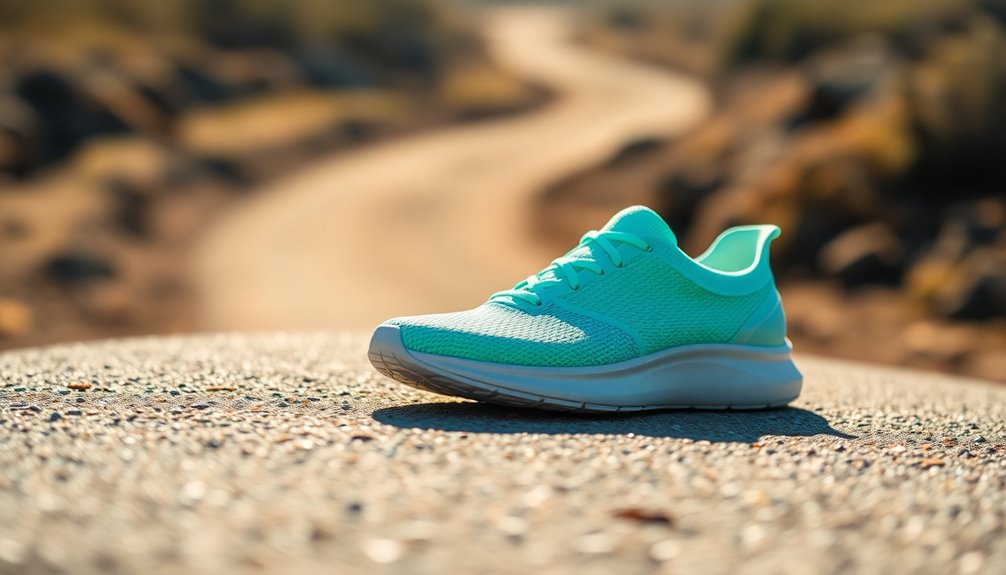
When I'm picking out minimalist trainers, I always consider several key factors to guarantee the best fit for my running style. Shoe weight and flexibility are essential, along with the toe box width and sole thickness. I also pay attention to fit variations and grip performance, as they can make a big difference on my runs.
Shoe Weight and Flexibility
Choosing minimalist trainers involves careful consideration of shoe weight and flexibility, as these factors profoundly impact your running experience. I've found that lightweight shoes considerably reduce fatigue during long runs, letting me go the distance without feeling bogged down. The flexibility of minimalist trainers allows my feet to move naturally, adapting to different terrains and enhancing my running gait. A flexible sole boosts my proprioception, giving me better feedback from the ground and improving my balance. However, I keep in mind the balance between weight and flexibility; too rigid a shoe can restrict my foot's natural motion, while excessive flexibility might compromise support. Striking that balance is essential for achieving an effective, enjoyable run.
Toe Box Width
While exploring minimalist trainers, toe box width quickly became a priority for me, as it plays a vital role in ensuring comfort during my runs. A wider toe box allows my toes to splay naturally, which not only enhances stability but also promotes proper foot biomechanics. I've noticed that many minimalist models cater to runners like me who prefer that extra space. However, I've learned that sizing can vary markedly among brands, so trying on different pairs is essential to find the perfect fit for my foot shape. Shifting from traditional shoes to minimalist trainers is easier when I opt for a wider toe box, helping me adapt comfortably and avoid issues like blisters or bunions.
Sole Thickness and Cushioning
Sole thickness and cushioning are essential elements I consider when selecting minimalist trainers for my runs. I love how these trainers typically feature thin soles, giving me a closer connection to the ground, which enhances my natural gait. With minimal cushioning, my feet engage more naturally with the terrain, promoting strength over time. I appreciate the zero-drop design found in many minimalist shoes, as it helps align my body and reduces injury risk, especially if I'm a forefoot or midfoot striker. However, I know that adapting to these shoes can be uncomfortable at first due to their lack of cushioning, so I always take my time to adjust based on my experience level and running style.
Fit and Sizing Variations
When I look for minimalist trainers, fit and sizing are essential factors that can make or break my running experience. These shoes often have a snug fit that feels like a glove, but sizing inconsistencies can vary across models or colors, so I always double-check before ordering. I appreciate a wide toe box for natural foot expansion, yet I've found some models can still feel narrow, prompting me to adjust my size. Sometimes, I even size down for a better fit, as my usual size can be looser than expected. Additionally, selecting the right insole thickness is vital—swapping insoles can enhance comfort. Finally, I remind myself to allow time to adapt to the minimalist feel, especially if shifting from traditional footwear.
Grip and Traction Performance
Choosing the right minimalist trainers means paying close attention to grip and traction, which can be the difference between a smooth run and a slippery struggle. The sole material and tread design are vital here; I've found that rubber compounds often provide the best grip across various surfaces. Trainers with a flatter profile and flexible soles give me better ground contact, enhancing traction during my runs. I also consider how the shoes perform on wet surfaces, as many minimalist options can struggle in those conditions. A well-constructed tread pattern is fundamental for uneven terrains, like rocky trails, where I need stability. Before buying, I always test shoes on different surfaces to confirm they meet my specific running needs.
Breathability and Material Quality
While I often focus on grip and traction, breathability and material quality are just as vital when selecting minimalist trainers. Breathable materials like mesh or knit fabrics allow for better airflow, keeping my feet dry and comfortable during long runs. This ventilation helps regulate temperature and moisture, reducing the risk of blisters and foot odor. I also look for trainers with moisture-wicking properties, as they further enhance foot hygiene by managing sweat. It’s essential that these breathable fabrics are durable enough to withstand wear and tear while maintaining their airflow capabilities. In my experience, a well-ventilated upper greatly improves my overall running experience, allowing for natural foot movement without overheating. Additionally, finding the right balance between cushioning and breathability can be a game-changer in my running routine. While minimalist designs typically favor a closer-to-ground feel, I sometimes explore the best cushioned trainers for runners, as they provide extra support during longer distances. These options ensure that, even with additional padding, my feet remain cool and dry, allowing for both comfort and performance as I tackle various terrains.
Durability and Construction Quality
As I immerse myself in selecting minimalist trainers, durability and construction quality become essential factors that I can't overlook. I always check for well-constructed seams and stitching, as these features greatly contribute to a shoe's longevity and help prevent premature wear. A durable sole made from high-quality rubber is vital, providing traction and maintaining performance across various terrains. The materials used also matter; lightweight and breathable fabrics enhance comfort while ensuring durability. I appreciate shoes with a thin removable insole, as they allow for customization during my shift to minimal cushioning. Finally, I know that regular maintenance, like cleaning and proper storage, can extend the lifespan of my minimalist trainers, making them resilient against my running routine.
Price and Value Comparison
Having established the importance of durability and construction quality, I find that price and value comparison also play significant roles in selecting minimalist trainers. These trainers typically range from about $27 to $43, making them a budget-friendly choice for runners interested in barefoot-style footwear. Many users see excellent value for money due to their durability and solid performance, often resulting in multiple purchases. Brands offering replacement insoles for around $2.99 extend the life of the shoes without sacrificing comfort. This affordability encourages more people to explore barefoot running without breaking the bank. It's encouraging to see that most users are willing to repurchase if the quality remains consistent, highlighting their overall satisfaction with these trainers.
Frequently Asked Questions
How Do Minimalist Trainers Improve Running Form and Technique?
I've found that minimalist trainers really enhance my running form. They encourage a more natural stride, letting my feet land beneath my body instead of far ahead. This helps me avoid overstriding and reduces the impact on my joints. Plus, the lightweight design makes me feel quicker and more agile. I notice that I'm more aware of my foot placement, which leads to better balance and efficiency during my runs.
Are Minimalist Shoes Suitable for All Foot Types?
When it comes to footwear, it's like finding the perfect dance partner—everybody's got different needs. Minimalist shoes aren't a one-size-fits-all solution. They can work wonders for some foot types, promoting natural movement and strength. However, if you've got specific issues like flat feet or high arches, it's essential to tread carefully. I always recommend trying them on and evaluating how they feel during a run before committing. Your feet will thank you!
What Surfaces Are Best for Running in Minimalist Trainers?
When I think about the best surfaces for running in minimalist trainers, I find that natural terrains like grass and dirt paths feel the best. These surfaces offer enough cushioning while still allowing me to connect with the ground. I've also enjoyed running on smooth asphalt, as it provides a good balance of support and responsiveness. However, I tend to avoid rocky trails or uneven ground—they can be tough on my feet and ankles.
How Long Do Minimalist Trainers Typically Last?
Imagine the feeling of the ground beneath your feet, each stride connecting you to the earth. When I wear minimalist trainers, I've found they typically last between 300 to 500 miles, depending on my running style and surface. I've noticed that the lightweight design can wear down quicker on rough terrain, so I keep an eye on the soles. It's all about finding that perfect balance between comfort and durability during my runs.
Can Beginners Safely Transition to Minimalist Running Shoes?
Absolutely, beginners can shift to minimalist running shoes, but it takes time. I started slowly, wearing them for short distances before gradually increasing mileage. Listening to my body was essential; if I felt discomfort, I'd take a step back. Strengthening my feet and calves helped too. I recommend focusing on form and building up gradually. With patience and care, I found the shift rewarding and my running improved considerably.
Conclusion
In the world of running, minimalist trainers are like a second skin, letting you feel the earth beneath your feet while you chase your personal best. As you lace up your chosen pair, remember that each step you take is a dance with freedom and agility. Whether you're hitting the trails or the pavement, these lightweight companions will support your journey, allowing you to tread lightly and run boldly into the horizon of your potential.
